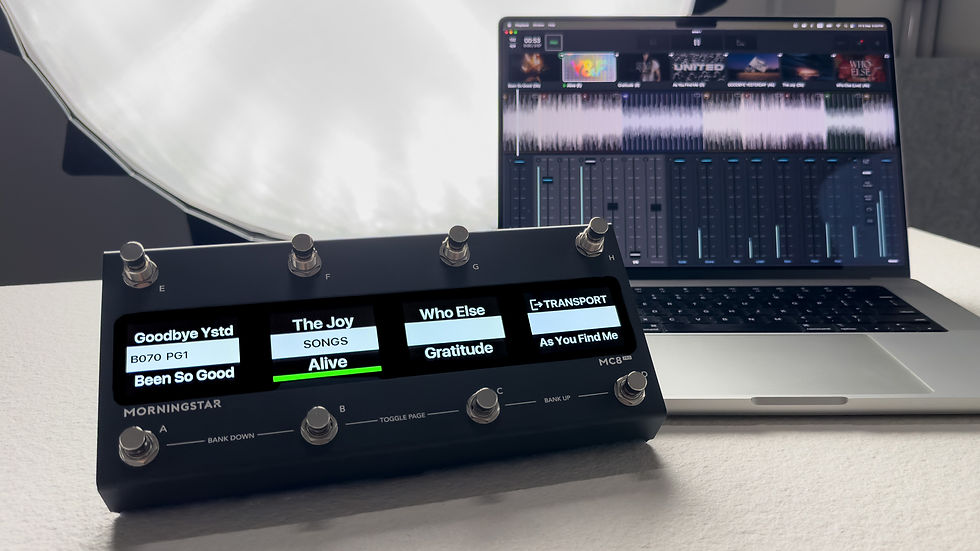Source Audio Nemesis & MC6 Midi Controller
- James

- Jul 30, 2018
- 3 min read
Introduction
The Source Audio Nemesis is one of the best and most versatile delays available. It gives you truly convincing tape/analog tones, pristine digital repeats and ethereal shimmer-type delays all in a compact stomp box. However, it also has a few huge drawbacks - namely its lack of foot access to its presets, and the absence of an LCD screen for visual feedback to the user. It also has 12 hidden delay engines that are difficult to access without MIDI. This is why the Nemesis and Morningstar MC6 midi controller are a match made in pedal heaven.

With just the Nemesis alone, you'll have to bend over and use your finger to change presets. And even then, you have access to only 8 of its 128 available preset slots, without the ability to know which preset you are selecting. Today, we solve all that and more.
You may refer to the Source Audio Nemesis User Guide and MIDI Implementation to find out which MIDI messages correspond to the various functions on the Nemesis.
Connecting the Nemesis and MC6
Connect the MIDI Out port of the MC6 to the MIDI In port of the Nemesis via a 5-pin MIDI cable. By default, the Nemesis receives messages on MIDI channel 1. Make sure that the messages sent from the MC6 are on the same channel as the Nemesis. You may change the the MIDI channel of the Nemesis via the Source Audio Neuro app if so desired.

Accessing Presets
With the MC6, you will be able to quickly and easily access all 128 presets on the Nemesis. To recall a preset, you simply need to send a Program Change (PC) message from the MC6 to the Nemesis. Preset slots 1 to 128 correspond to PC numbers #0 to #127. Sending PC number #0 recalls preset 1, number #2 recalls preset 3, number #127 recalls preset 128 and so on. Also you can name each of your presets on the MC6 so you know exactly what you are engaging. As shown here:

Accessing Hidden Delay Engines
12 of the Nemesis delay engines are only accessible with MIDI or the Neuro app. Some of these include the Warped Record, Tremolo and Complex Rhythmic engines, which are great-sounding and give you a ton of useable tones. To access these engines, simply send a Control Change (CC) message #1 with the appropriate value to access each delay engine. The various engines correspond to the values as shown in the table below:

Engaging and Bypassing the Nemesis
Using the MC6, you can also engage and bypass the Nemesis via MIDI. To do this, you just need to send CC message number #38 to the Nemesis. Values more than or equal to 64 will engage the Nemesis, while values less than or equal to 63 will bypass it. In this example, I programmed 2 messages to the same MC6 switch in different toggle positions. Message 1 (CC#38, Value 127, toggle position 1) engages the Nemesis, while Message 2 (CC #38, Value 0, toggle position 2) bypasses it. Be sure to set Toggle to 'On' and give your switch a Toggle Name as well. The MC6 settings for this can be seen here:


MIDI Clock
The MC6 can also send MIDI Clock data to the Nemesis. The MIDI clock tempo can pre-set or tapped in on the MC6, allowing you to sync the Nemesis with your other time-based effects. To do this, simply select the MIDI Clock message type on the MC6. Set 'Show Tap Menu' to "Yes" if you would like to be able to tap tempo on the fly. When you step on the MC6 switch assigned to the MIDI clock function, you will enter MIDI clock mode and be able to tap and change the tempo of the Nemesis (together with other pedals) on the fly.

Conclusion
These are just some of the things you can do with the MC6 and Nemesis. The Source Audio Nemesis is surely one of the best super delays around today. The MC6 midi controller overcomes its shortcomings and gives you the much needed control over it, making it a truly effective and useful multi-purpose weapon for your live performances.


